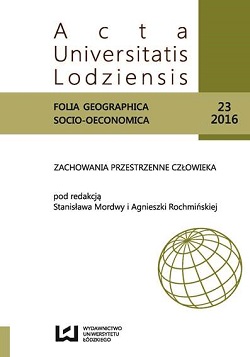Spatial behaviours of shopping centre customers – the example of Łódź
DOI:
https://doi.org/10.18778/1508-1117.23.01Keywords:
spatial behaviour, shopping centre, ŁódźAbstract
Political and economic transformations in Poland in the 1990s influenced the functioning of trade in Poland, also in Łódź. The Polish market saw new types of retail outlets, including shopping centres, and, therefore, influenced the changes in the development of cities or their parts as well as the behaviours of the residents and other subjects. In relation to those changes that have yet to be complete this article presents the development and the characterization of shopping centres with FMCG products (Fast moving consumer foods) in Łódź. However, the main purpose of the work was to ponder the multi-aspect nature of “spatial behaviours” often applied solely to the behaviours of people (customers) and present elements associated with these behaviours. Spatial behaviours connected with new retail outlets such as shopping centres, initially of the 1st and 2nd generation and later of the 3rd and 4th generation appearing in Łódź in the 1990s were and still are subject to change. On the one hand, it is connected to the transformation of space occurring as a result of building these modern complexes and their influence on their surroundings, as even the smallest complexes are large enough to form the areas of influence and shape the city space and even areas outside the city. Shopping centres have transformed many cityscapes, influencing, among others, the changes in land development, the structure of business entities (specialized retail outlets – Praktiker, Castorama, Obi – were created in their neighbourhoods), infrastructural investments, the reorganization of traffic. However, it should be remembered that the range, force and nature of a shopping centre’s influence on its surroundings depends on its following features: the location, accessibility, working hours, size, the type and form of offered services. On the other hand, the location and attractiveness influence the spatial behaviours of decision-makers associated with the shopping centres, city residents, the owners of business entities, providers/customers and also, above all, the population which constitutes the potential clients. Shopping centres, with their wide variety of offers, have been attracting customers, and, therefore, changing migratory directions, shopping habits, the ways of spending free time. They have created a fashion for visiting these “temples of consumption” and, by extension, influenced the life of local people.
References
Ciechomski W., 2010, Koncentracja handlu w Polsce i jej implikacje dla strategii konkurowania przedsiębiorstw handlowych, Wydawnictwo UE, Poznań.
Google Scholar
Colliers International, 2015, Łódzki rynek nieruchomości.
Google Scholar
Cushman & Wakefield, 2015, Łódzki rynek nieruchomości.
Google Scholar
Dedal Invest-Eko, 2001, Prognoza skutków Centrum Handlowo-Usługowego na obszarze objętym mpzp Rataje-Łacina w Poznaniu dla rynku pracy, komunikacji, istniejącej sieci handlowej oraz zaspokajania potrzeb i interesów konsumentów, Poznań.
Google Scholar
DTZ Research, 2009, Rynek powierzchni handlowych Polska, www.detaldzisiaj.com.pl
Google Scholar
Foryś I., 2014a, Otoczenie społeczno-gospodarcze polskiego handlu, [w:] Foryś I. (red.), Zarządzanie nieruchomościami handlowymi, Wydawnictwo Poltext, Warszawa, s. 13–44.
Google Scholar
Foryś I., 2014b, Obiekt handlowy w przestrzeni miejskiej, [w:] Foryś I. (red.), Zarządzanie nieruchomościami handlowymi, Wydawnictwo Poltext, Warszawa.
Google Scholar
Geurs K.T., Ritsema van Eck J.R., 2001, Accessibility Measures: Review and Applications. Evaluation of Accessibility Impacts of Land-Use Transport Scenarios and Related Social and Economic Impacts, RIVM report 408505 006, National Institute of Public Health and the Environment, Bilthoven.
Google Scholar
Kaczmarek J., 2005, Podejście geobiograficzne w geografii społecznej. Zarys teorii i podstawy metodyczne, Wydawnictwo UŁ, Łódź.
Google Scholar
Kaczmarek T., 2010, Struktura przestrzenna handlu detalicznego. Od skali globalnej do lokalnej, Wydawnictwo Bogucki, Poznań.
Google Scholar
Ledwoń S., 2012, Analiza możliwości rozmieszczenia funkcji handlowej na terenie miasta Elbląga, Urbis, Gdańsk.
Google Scholar
Łobos M., 2001, Turystyka weekendowa w strefie przymiejskiej Wrocławia, „Architectusˮ, 1–2, s. 153–158.
Google Scholar
Makowski G., 2003, Świątynia konsumpcji. Geneza i społeczne znaczenie centrum handlowego, Trio, Warszawa.
Google Scholar
Matysiak N., 2009, Współczesne centra handlowe w Polsce, „Handel wewnętrzny” – Rynek, przedsiębiorstwo, konsumpcja, marketing, 6(323), IBRKiK, Warszawa.
Google Scholar
Panasiuk A., 2010, Organizacja multiusługowa, [w:] Rogoziński K., Panasiuk A., (red.), Zarządzanie organizacjami usługowymi, „Zeszyty Naukowe”, 145, Uniwersytet Ekonomiczny, Poznań, s. 73–82.
Google Scholar
Pióro Z., 1982, Ekologia społeczna – nauka o strukturach i zachowaniach przestrzennych, [w:] Pióro Z. (red.), Przestrzeń i społeczeństwo. Z badań ekologii społecznej, Wydawnictwo Książka i Wiedza, Warszawa, s. 113–130.
Google Scholar
Poland retail destinations, 2015, Wydawnictwo CBRE, Warszawa.
Google Scholar
Polska Rada Centrów Handlowych (PRCH), 2012, http://prch.org.pl/PL/BazaWiedzy/Definicje/Default.aspx (dostęp: 12.03.2012).
Google Scholar
Regulski J., 1986, Planowanie miast, PWE, Warszawa.
Google Scholar
Rochmińska A., 2005, Rozwój sieci handlowych z udziałem kapitału zagranicznego, [w:] Dzieciuchowicz J. (red.), Usługi rynkowe w dobie transformacji, Wydawnictwo UŁ, Łódź, s. 65–92.
Google Scholar
Rochmińska A., 2010, Sieci handlowe z kapitałem zagranicznym jako nowy element w strukturze miasta, [w:] Jażdżewska I. (red.), Duże i średnie miasta polskie w okresie transformacji, XXII Konwersatorium Wiedzy o Mieście, t. 1, Wydawnictwo UŁ, Łódź.
Google Scholar
Rochmińska A., 2013, Atrakcyjność łódzkich centrów handlowych oraz zachowania nabywcze i przestrzenne ich klientów, Wydawnictwo UŁ, Łódź.
Google Scholar
DOI: https://doi.org/10.18778/7525-865-3
Rudnicki L., 2000, 2012, Zachowania konsumentów na rynku, PWE, Warszawa.
Google Scholar
Sierpiński G., 2010, Miary dostępności transportowej miast i regionów, „Zeszyty Naukowe Politechniki Śląskiej”, seria Transport, 66, s. 91–96.
Google Scholar
Skolik S., 2015, Zachowania terytorialne w Internecie a inflacja przestrzeni społecznej, „Przestrzeń Społecznaˮ, 1, s. 1–14.
Google Scholar
Szul R., 1991, Przestrzeń. Gospodarka. Państwo, Rozwój regionalny – Rozwój lokalny – Samorząd terytorialny, 26, Uniwersytet Warszawski, Europejski Instytut Rozwoju Lokalnego i Regionalnego, Warszawa.
Google Scholar
Wojnowski W., 2012, Plaza Centers: otwarcie Łódź Plaza nastąpi w 2014 roku, http://www.retailnet.pl/Wspolna/Wiadomosci/2012/Maj/22/Plaza-Centers-otwarcie-lodz--Plaza-nastapi-w-2014-.aspx (dostęp: 24.08.2012).
Google Scholar
Downloads
Published
How to Cite
Issue
Section
License

This work is licensed under a Creative Commons Attribution-NonCommercial-NoDerivatives 4.0 International License.








